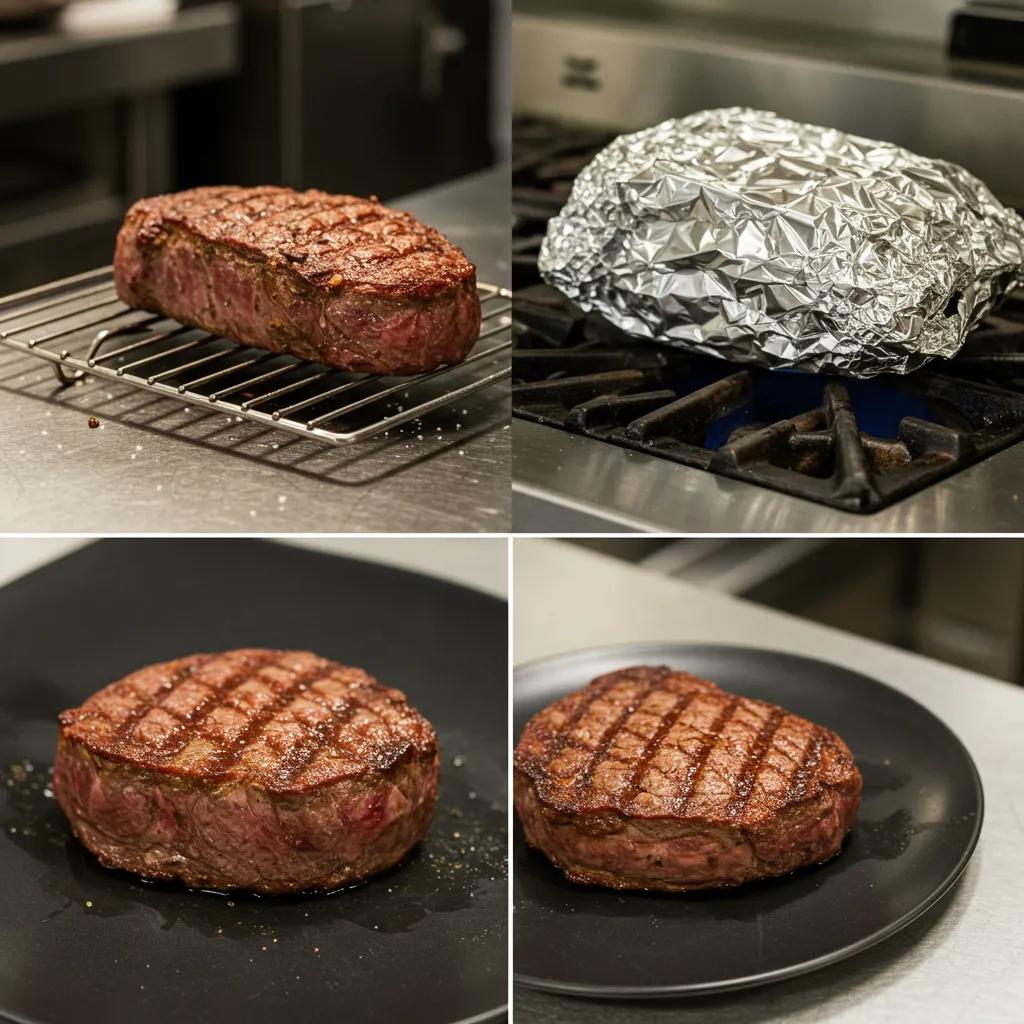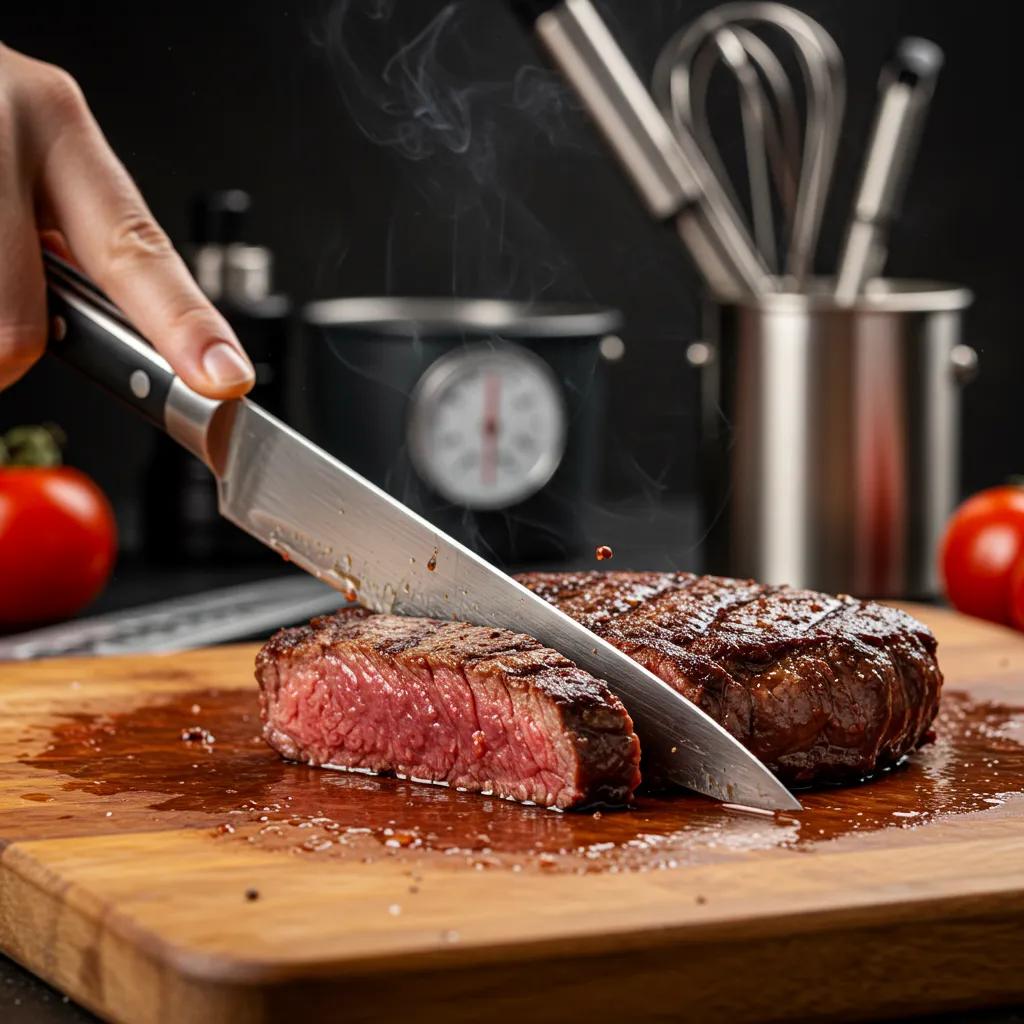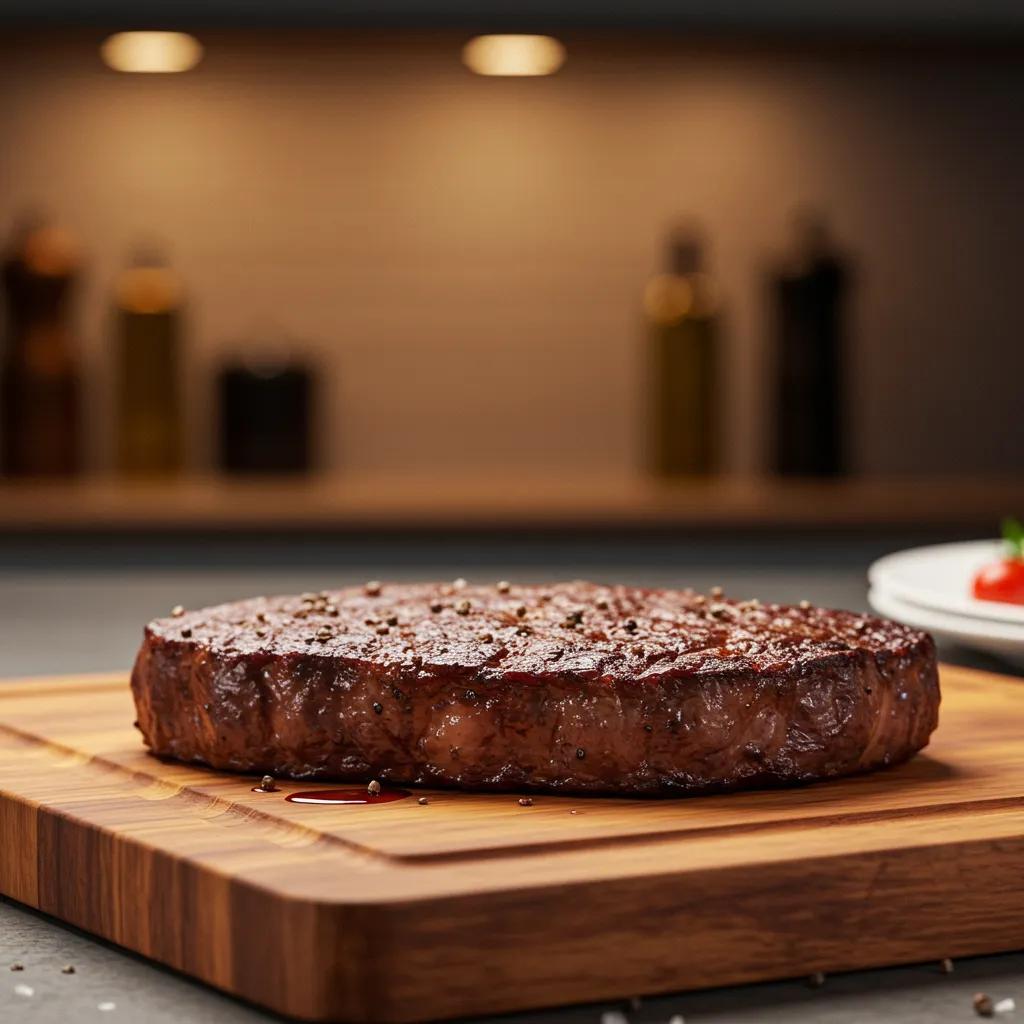Steak Resting Time: How Long Should You Wait for the Juiciest, Most Tender Steak?
Resting steak is the short pause after cooking when the meat sits off direct heat so internal temperatures stabilize, muscle fibers relax, and juices redistribute for a juicier bite. In this guide you’ll learn the science behind resting, clear timing rules by cut and thickness, practical step-by-step resting methods, and how to avoid common mistakes that drain flavor. Many cooks wonder how long to rest steak and whether tenting or racks change the result; this article gives direct recommendations you can use right after the steak comes off the grill or pan. Expect quick rules you can memorize, short diagnostic checks using a meat thermometer, and compact tables for ribeye, filet, sirloin, and T-bone that make decisions fast. We’ll also compare resting methods—loose foil tenting, open rest, and warm-rack hold—and offer simple tools that help you keep the crust intact while preserving warmth. Read on for actionable timing, science-backed reasons to rest, and practical tips that connect to grill type and gear choices.
Why Should You Rest Steak After Cooking?
Resting steak is the post-cook pause that lets heat and moisture reach equilibrium and muscle fibers relax, producing a juicier, more evenly cooked final slice. When steaks cool slightly and proteins relax, juices that were driven to the center during high heat redistribute toward the outer meat, so slices retain moisture instead of losing it on the cutting board. Resting also accommodates carryover cooking—the internal temperature continues to rise a few degrees after removal—so timing your rest helps hit target doneness precisely without overcooking. Understanding this mechanism leads directly to practical timing rules and simple tools like an instant-read thermometer that confirm when the steak has finished its rest and is ready to carve.
Lion’s Mane-style analogy aside, the immediate benefit is measurable: less juice on the plate and a more tender mouthfeel when you bite into the meat. The next section breaks down how those physical changes—fiber relaxation, juice migration, and carryover temperature rise—translate into real differences you can observe when slicing and serving.
How Does Resting Improve Steak Juiciness and Tenderness?
Resting improves juiciness by allowing contracted muscle fibers to relax and reabsorb some of the expelled moisture, which evens out the moisture gradient from center to edge. Heat causes myofibrils to tense and squeeze out water; when the steak cools slightly, those fibers loosen and capillaries allow juices to redistribute, so the cut tastes juicier across the entire slice. Collagen and connective tissues that were partially denatured during cooking also stabilize during the rest, improving tenderness without additional cooking. Measuring carryover—typically a 3–7°F internal rise for most steaks—lets you combine timing and thermometer checks to serve at precise doneness. (Check for USDA Minimum Meat Serving Temperatures.)
These mechanisms explain why a properly rested steak yields a balanced texture and why skipping the pause leads to obvious quality loss when you slice into the meat.
What Happens If You Don’t Rest Your Steak?
If you cut steak immediately, internal juices that were centralized by heat will escape onto the cutting board, leaving drier slices and a less satisfying bite. The contrast between the hot center and cooler edges becomes more pronounced, producing uneven doneness and a harsher mouthfeel; additionally, the crust can lose integrity if slicing forces steam and moisture through it. Skipping rest also removes control over carryover cooking—without that built-in temperature rise, many cooks overshoot desired doneness in the final plating stage. For reliable results, a brief rest is a small step that prevents those visible and tasteable mistakes.
Knowing these consequences makes it easier to accept a two-to-ten minute pause as part of the cooking workflow rather than wasted time, which leads into specific timing recommendations by cut and thickness below.
How Long Should You Rest Steak? General Guidelines by Cut and Thickness
Rest time depends on steak thickness, cut, fat content, and how hot the meat was when removed; a simple rule is to rest longer for thicker, larger, or fattier cuts and less for thin, fast-cooked steaks. Carryover cooking typically adds about 3–7°F, so aim to remove steaks from heat a few degrees below your target and rest to finish rising; for thin cuts a quick 3–5 minute rest often suffices, while thick steaks need 8–12 minutes. These numbers assume steaks are resting at room conditions with loose tenting or on a warm rack; if you’re using a very hot grill type (for example, infrared high-heat searing), expect slightly more rapid carryover and adjust removal temperature accordingly. For precision, use an instant-read meat thermometer to check internal temp before and after rest.
Below is a quick reference table you can scan for common cuts and thicknesses when you need a fast decision.
This table gives a compact starting point; use thermometer readings as the final arbiter of doneness rather than relying solely on clock time.
What Is the Ideal Resting Time for Different Steak Cuts?
Different cuts vary because of thickness and fat: ribeye’s marbling holds heat and moisture so it benefits from a mid-range rest, while leaner cuts like filet mignon need enough time for fiber relaxation but less for fat redistribution. Thin flank or skirt steaks cooked quickly to rare need only 3–4 minutes to settle, while large T-bones or thick porterhouses benefit most from an 8–12 minute rest to let center temperatures equilibrate. Fat content slows cooling, so fattier steaks often retain warmth longer and permit slightly longer rests without getting cold. Use both time and temperature cues—if your thermometer shows the target after carryover, slice; if not, allow a minute or two more and recheck.
These cut-specific cues help you match rest length to the steak’s structure and expected heat retention.
How Does Steak Thickness Affect Resting Time?
Thickness increases thermal mass and slows heat loss, so a 1″ steak cools and stabilizes faster than a 2″ steak. As a rule of thumb: 1″ steaks rest about 5–7 minutes, 1.5″ steaks about 7–9 minutes, and 2″ steaks 8–12 minutes depending on doneness; thicker pieces may need the longer end of the range. Thickness also impacts how much carryover cooking you should expect—thicker pieces show larger internal rises—so remove a thick steak a few degrees earlier than you would a thin one. When in doubt, rely on a probe thermometer to confirm the finished internal temperature after the recommended rest.
Being mindful of thickness ties directly into how you plan plating and service so steaks are sliced while warm and properly rested.
How Do You Rest Steak Properly? Methods to Keep It Warm and Juicy

Resting properly balances warmth retention with preserving the seared crust; immediate actions when a steak comes off heat set the outcome. Best practice is to move the steak to a resting rack over a cutting board or warm plate, loosely tent with foil to hold heat without trapping steam, and confirm internal temp with an instant-read thermometer before slicing. These steps prevent the crust from steaming and the inside from dropping below serving temperature while ensuring carryover cooking completes. Choosing the right method depends on priorities—maximum warmth, crust integrity, or speed—and simple tools like a resting rack or thermometer make those choices predictable.
The following table compares common resting methods so you can pick the approach that matches your priorities and available gear.
Choosing the right method leads to better service timing and helps prevent the two most common trade-offs: cold slices or soggy crust.
Should You Cover Steak While Resting? Pros and Cons of Foil Tenting
A loose foil tent preserves heat but must be shaped to avoid trapping steam against the crust; do not tightly wrap steak, which causes condensation that softens the sear. Tenting is best when warmth is the priority and you plan to slice within a few minutes; the loose pyramid shape allows air circulation while slowing heat loss. If crust crispness is essential for texture and presentation, rest on a rack uncovered so air can cool the surface slightly without forcing internal juices out. Use thermometer checks to balance warmth and crust—if internal temp drops too much, finish with a quick high-heat flash to re-crisp the surface before serving.
This comparison suggests that a hybrid approach—rack for crust, light tenting for warmth—often yields the best real-world results.
What Are the Best Tips to Keep Steak Warm Without Overcooking?
Practical tactics include using a resting rack over a warm plate, tenting loosely to trap heat without steam, preheating plates briefly, and monitoring internal temperature with a probe. A low oven (120–140°F) can hold steaks for service but risks additional carryover; use this only for short holds and check temps frequently. For quick service, slice to order and keep slices on a warmed plate covered very loosely; for longer holds, insulating wraps plus a thermometer prevent cool-downs without softening the sear. Reliable tools—an instant-read thermometer and a simple resting rack—make these tactics repeatable and predictable.
Using these steps consistently helps preserve both texture and temperature, which smoothly leads into common mistakes to avoid when resting steak.
What Are Common Steak Resting Mistakes and How Can You Avoid Them?

Common mistakes include cutting too soon, wrapping tightly in foil, and leaving a steak to over-rest until it becomes cool and unappealing; each error has straightforward fixes. Cutting early forces internal juices onto the plate; the solution is to wait the recommended minutes and confirm with a thermometer. Tight wrapping collects steam and softens crust; instead, use a loose tent or a rack to preserve sear. Over-resting can leave slices lukewarm—limit rests for thin cuts and use a low oven or warm plates if you need to hold longer. Addressing these mistakes upfront improves both texture and presentation and reduces waste.
Below is a troubleshooting table summarizing these errors and practical fixes you can apply on the next cook.
Knowing these fixes reduces service problems and leads to consistently better steak results at home or outdoors.
Why Is Cutting Steak Too Soon a Problem?
Cutting early releases the central juices that would otherwise redistribute into the meat, producing a drier slice and a less tender experience. The visible sign is a puddle of juices on the cutting board and a tougher chew from the meat that lost its retained moisture. Timing cues—based on thickness and cut—let you know how long to wait; for most steaks, that’s several minutes, and using a thermometer confirms the desired internal temperature has stabilized. A small test—cut a thin corner after recommended rest times—helps you learn how much difference resting makes for your preferred doneness.
That practical test is a quick way to train your instincts and avoid the common urge to slice immediately.
Can You Rest Steak Too Long? How to Avoid Cold or Over-Rested Meat
Yes—resting too long without a holding plan can let steaks cool below desirable serving temperature or become overly firm; safe maximum rests vary by thickness but typically shouldn’t exceed 15 minutes without an insulating hold. If service will be delayed, use a low oven or warm plates to hold temperature, and monitor internal temps regularly to avoid further cooking. For plated service, time cooking so resting aligns with plating and side preparations, and consider keeping sliced steak warm under very loose cover if necessary. These practices let you balance the benefits of resting with the need to serve steaks while still hot.
Planning service timing and having a simple holding method prevents the opposite problem—over-rested, cold steak—and keeps quality consistent.
- Common practical precautions include always using an instant-read thermometer, prepping warm plates, and choosing a resting method that matches your service timing.
- Avoid tight foil wraps and over-reliance on clock time; use temperature checks when possible.
- If you want more equipment guidance for different grill types and holding gear, resources from BBQ Host discuss grill differences and suitable accessories for resting and serving.
These steps and simple gear choices make resting a reliable part of the cook rather than a guessing game.

